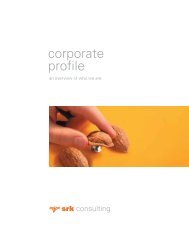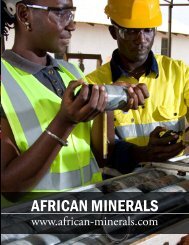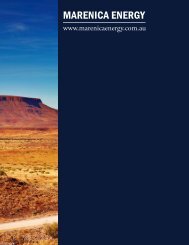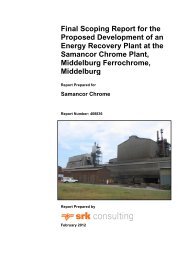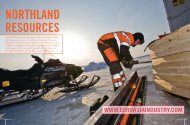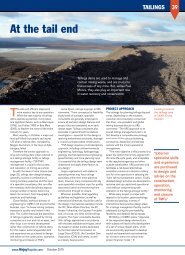Draft Status Quo Report for the Pixley Ka Seme ... - SRK Consulting
Draft Status Quo Report for the Pixley Ka Seme ... - SRK Consulting
Draft Status Quo Report for the Pixley Ka Seme ... - SRK Consulting
You also want an ePaper? Increase the reach of your titles
YUMPU automatically turns print PDFs into web optimized ePapers that Google loves.
<strong>SRK</strong> <strong>Consulting</strong> in association with BKS<br />
<strong>Pixley</strong> <strong>Ka</strong> <strong>Seme</strong> Local Municipality EMF – <strong>Draft</strong> <strong>Status</strong> <strong>Quo</strong> <strong>Report</strong> Page 20<br />
3 <strong>Status</strong> quo of <strong>the</strong><br />
environment<br />
This chapter presents <strong>the</strong> current state of environment in<br />
<strong>the</strong> PKSLM.<br />
3.1 Regional locality<br />
The PKSLM is located in south-eastern Mpumalanga<br />
within GSDM. The PKSLM covers an area of 522,204<br />
ha and falls in <strong>the</strong> grassland biome – one of <strong>the</strong> most<br />
threatened biomes in South Africa. The Vaal River<br />
<strong>for</strong>ms part of <strong>the</strong> municipality’s nor<strong>the</strong>rn boundary and<br />
KwaZulu-Natal (KZN) and Free State <strong>for</strong>m <strong>the</strong><br />
sou<strong>the</strong>rn boundary. Major roads such as <strong>the</strong> R23 and<br />
N11 as well as a national rail link between Gauteng and<br />
KZN traverse <strong>the</strong> municipal area (see Map 1).<br />
PKSLM is predominantly rural in nature, with<br />
Volksrust being <strong>the</strong> sole major urban centre. The town<br />
is located on <strong>the</strong> border with KZN on <strong>the</strong> N11 which<br />
provides road access <strong>for</strong> freight and <strong>the</strong> tourist public.<br />
Volksrust provides administrative and commercial<br />
services to <strong>the</strong> surrounding centres and areas within<br />
PKSLM. Daggakraal is a densely settled area which<br />
supports approximately 33% of <strong>the</strong> PKSLM population,<br />
but is relatively poorly supplied with infrastructure and<br />
services. O<strong>the</strong>r smaller centres are located at<br />
Wakkerstroom, Amersfoort/Zamokuhle, Singobile,<br />
Siyasenzele, Ezamokuhle, Zizameleni, Perdekop and<br />
Daggakraal (see Map 2).<br />
(MAP) ranging from 600 to 800 mm in <strong>the</strong> west<br />
increasing to 800 to 1,000 mm in <strong>the</strong> east. The area<br />
upstream of <strong>the</strong> Heyshope Dam in <strong>the</strong> Usutu to<br />
Mhlatuze WMA receives more than 1,000 mm/ a.<br />
Summer rainfall is accompanied by severe<br />
thunderstorms.<br />
Summer temperatures range up to 40°C during <strong>the</strong> day,<br />
down to 10°C in <strong>the</strong> evening. Temperatures range from<br />
20°C during <strong>the</strong> day to 10°C at night during <strong>the</strong> mild<br />
winter. Light frost can occur from May to August and is<br />
expected on less than 30 days per annum. Wind speeds<br />
range from 1 m/s to just less than 8 m/s.<br />
Climate change<br />
Climate change could have a major effect on ecology<br />
and land use in <strong>the</strong> PKSLM. Widespread melting of<br />
snow and ice, and rising sea levels, are among <strong>the</strong> most<br />
obvious and undeniable indicators that global air<br />
temperatures are rising. The increase has been attributed<br />
to increased emissions of GHGs from various sources,<br />
mainly <strong>the</strong> combustion of oil, coal and gas (Bates et al.,<br />
2008). However, <strong>the</strong> relationship between global<br />
temperatures and human activities is highly complex,<br />
and <strong>the</strong>re is little agreement as to how much climate is<br />
affected by human activities. Likewise, <strong>the</strong> impact of<br />
global warming on agriculture is highly uncertain.<br />
Elevated concentrations of carbon dioxide are predicted<br />
to have a positive effect on plant growth, but this may<br />
be offset by increased evaporative demands as<br />
temperatures rise (Bates et al., 2008).<br />
The neighbouring local municipalities within <strong>the</strong><br />
GSDM are Lekwa, Msukaligwa and Mkhondo (see Map<br />
3). The local municipalities of Newcastle, Utrecht and<br />
Edumbe fall within KZN and border PKSLM to <strong>the</strong><br />
south. Phumelela lies to <strong>the</strong> south-west of PKSLM and<br />
is situated in Free State Province.<br />
3.2 Biophysical<br />
3.2.1 Climate<br />
PKSLM is situated in a subtropical climate zone where<br />
summer rainfall occurs from September to May, 95%<br />
falling from October to March. Maximum rainfall is<br />
usually in January or February, while 95% of <strong>the</strong><br />
rainfall is experienced during <strong>the</strong> summer months. The<br />
eastern parts of PKSLM experience higher rainfall that<br />
<strong>the</strong> western region, with mean annual precipitation<br />
The Intergovernmental Panel on Climate Change<br />
The Intergovernmental Panel on Climate Change<br />
(IPCC) is <strong>the</strong> leading body <strong>for</strong> <strong>the</strong> assessment of<br />
climate change, established by <strong>the</strong> UNEP and <strong>the</strong> World<br />
Meteorological Organization. In 2007 <strong>the</strong> IPCC<br />
reported that some areas of <strong>the</strong> world are likely to<br />
become wetter as temperatures rise, while o<strong>the</strong>r areas,<br />
including most of sou<strong>the</strong>rn Africa, are likely to become<br />
dryer (Bates et al., 2008). Likewise, climate variability<br />
is predicted to increase in some areas, and decrease in<br />
o<strong>the</strong>r areas (Bates et al., 2008). Cold days, cold nights<br />
and frosts are likely to become less frequent over most<br />
land areas. Aquatic ecosystems are predicted to be<br />
among <strong>the</strong> most vulnerable to climate change (Bates et<br />
al., 2008). In sou<strong>the</strong>rn Africa, surface water quality is<br />
KILI/BEAT G:\404946_PIXLEY EMF\7REPORTS\<strong>Status</strong> <strong>Quo</strong> report\<strong>Draft</strong> report\<strong>Draft</strong> status quo report, July 2010.docx July 2010



